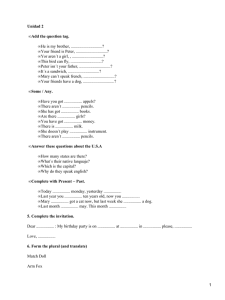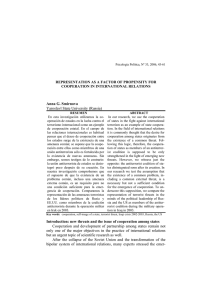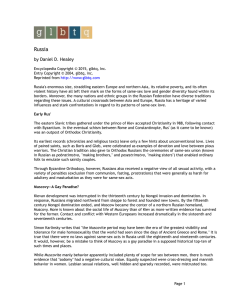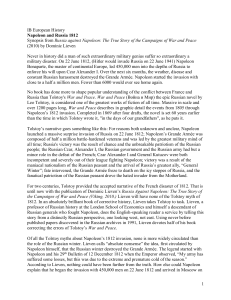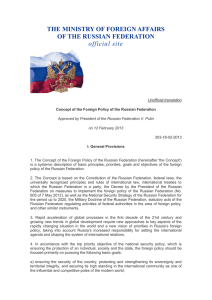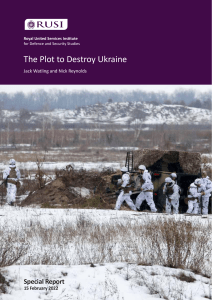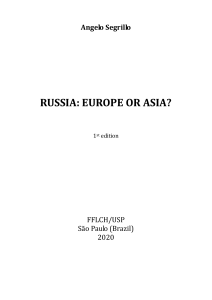CHAPTER 55 : RUSSIA ENTERS THE MODERN ERA FROM
Anuncio
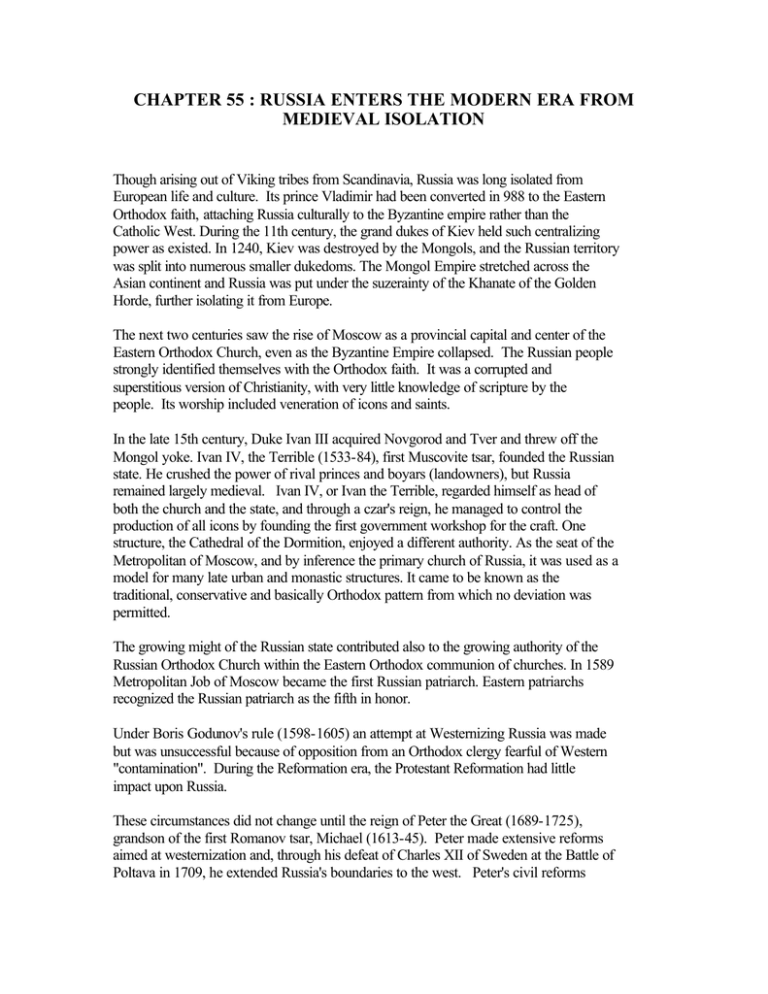
CHAPTER 55 : RUSSIA ENTERS THE MODERN ERA FROM MEDIEVAL ISOLATION Though arising out of Viking tribes from Scandinavia, Russia was long isolated from European life and culture. Its prince Vladimir had been converted in 988 to the Eastern Orthodox faith, attaching Russia culturally to the Byzantine empire rather than the Catholic West. During the 11th century, the grand dukes of Kiev held such centralizing power as existed. In 1240, Kiev was destroyed by the Mongols, and the Russian territory was split into numerous smaller dukedoms. The Mongol Empire stretched across the Asian continent and Russia was put under the suzerainty of the Khanate of the Golden Horde, further isolating it from Europe. The next two centuries saw the rise of Moscow as a provincial capital and center of the Eastern Orthodox Church, even as the Byzantine Empire collapsed. The Russian people strongly identified themselves with the Orthodox faith. It was a corrupted and superstitious version of Christianity, with very little knowledge of scripture by the people. Its worship included veneration of icons and saints. In the late 15th century, Duke Ivan III acquired Novgorod and Tver and threw off the Mongol yoke. Ivan IV, the Terrible (1533-84), first Muscovite tsar, founded the Russian state. He crushed the power of rival princes and boyars (landowners), but Russia remained largely medieval. Ivan IV, or Ivan the Terrible, regarded himself as head of both the church and the state, and through a czar's reign, he managed to control the production of all icons by founding the first government workshop for the craft. One structure, the Cathedral of the Dormition, enjoyed a different authority. As the seat of the Metropolitan of Moscow, and by inference the primary church of Russia, it was used as a model for many late urban and monastic structures. It came to be known as the traditional, conservative and basically Orthodox pattern from which no deviation was permitted. The growing might of the Russian state contributed also to the growing authority of the Russian Orthodox Church within the Eastern Orthodox communion of churches. In 1589 Metropolitan Job of Moscow became the first Russian patriarch. Eastern patriarchs recognized the Russian patriarch as the fifth in honor. Under Boris Godunov's rule (1598-1605) an attempt at Westernizing Russia was made but was unsuccessful because of opposition from an Orthodox clergy fearful of Western "contamination". During the Reformation era, the Protestant Reformation had little impact upon Russia. These circumstances did not change until the reign of Peter the Great (1689-1725), grandson of the first Romanov tsar, Michael (1613-45). Peter made extensive reforms aimed at westernization and, through his defeat of Charles XII of Sweden at the Battle of Poltava in 1709, he extended Russia's boundaries to the west. Peter's civil reforms included revising the alphabet; opening vocational schools, schools in math, navigation, engineering, and medicine; and establishing a Russian naval academy. Peter's reforms affected religious as well as civil life. The Russian people, who had been barbarously ignorant and very superstitious, were better instructed in religion under Peter's regime. He set up schools of learning, ordered the Bible to be printed in the language of the country, made a law that every family should keep the scriptures in their houses, that every person should be able to read the same, and that no person should be allowed to marry till they were able to read the scriptures. He also reformed the churches of his country of many of their superstitions, whereby the religion professed and practiced in Russia became much nearer to that of the Protestants than formerly it had been. This emperor gave great encouragement to the exercise of the Protestant religion in his dominions. Furthermore, there was a very considerable propagation of the gospel among the heathen in the extensive dominions of Russia. A great part of the vast dominions of Peter were gross heathens. The greater part of Great Tartary, a heathen country, was brought under the Muscovite government. Subsequently, great numbers renounced their heathenism, and embraced the Christian religion. During the course of Russian history, most often the tsar's civil government dominated its established Orthodox church, but there were times of more parity, or even dominance by the church authorities over the civil government. During the 17th century, an unusual coincidence increased the authority of the Russian Orthodox Church. Under Czar Michael, the patriarchal church throne was occupied by his father, Filaret, from 16191633. The czar was weak but the patriarch was strong. Under Peter the Great, however, the Russian Orthodox Church was more than ever before a subordinate instrument of the national state. Peter reformed the organization of the established church to be more consistent with the Biblical Protestant model. After the death of Patriarch Adrian in 1700, Peter delayed the election of the new Primate of the church and established in 1721 a collective supreme administration in the church known as the Holy and Governing Synod. The Synod remained the supreme church body in the Russian Church for almost two centuries. Catherine the Great, who reigned from 1762-96, continued Peter's westernization program and also expanded Russian territory, acquiring the Crimea, Ukraine, and part of Poland. Since the west was increasingly influenced by Enlightenment thought, this affected her administration as well. Catherine was actually not Russian by birth at all, but rather German. She was born Sophia Augusta Frederika of Anhalt-Zerbst in 1729. Her father, Prince Christian Augustus of Anhalt-Zerbst, was a minor prince and a high ranking officer in the Prussian Army. Her father was not even asked to come to the marriage of his daughter and the crown prince of Russia, owing to his staunch Lutheranism. She went against her father's wishes in changing her religion. The Orthodox and Lutheran churches were rivals, yet Catherine had to become Orthodox in order to marry the future Russian tsar, Peter. This Peter was the grandson of Peter the Great. When she arrived in Russia, she noticed a certain frailty about Peter, and that he was prone to all sorts of illnesses. Sophia also noticed that he occupied himself with childish games. In addition, Peter was a firm believer in the Lutheran faith and loved everything Prussian. King Frederick was his hero. Sophia herself started to learn the Russian language and to study the Orthodox religion. She was received into the Orthodox Church in a great ceremony. The next day the bethrothal took place and Princess Sophia of Anhalt-Zerbst became Grand Duchess Ekaterina Alexeyevna. Shortly after, Peter contracted the measles, then he started to show all the symptoms of small pox. He knew how unattractive he was, which eroded the little confidence he had. Catherine thought him to be a most pitiful creature and it was with dismay that she looked towards her wedding day. By now Peter drank excessively and his behavior became crude. The court was back in St. Petersburg, and after several postponements, the wedding took place in 1745. The young couple settled down, but the marriage was a miserable failure. Catherine occupied herself with reading everything she could lay her hands on. She discovered satisfaction, as she moved from the works of Plato to the works of Voltaire. She was steeped in Enlightenment propaganda. Her interest in the intellect caused an even greater estrangement between herself and Peter, who began to avoid her. This estrangement eventually led to a coup. Many Russians were unhappy with how Tsar Peter had capitulated to the Prussians in war. Some conspirators enticed Catherine to join their coup, ostensibly because Tsar Peter threatened Catherine. A manifesto was printed and distributed to the Russian people: "We, Catherine II, It has been clearly apparent to all true sons of our Russian Fatherland that the State of Russia has been exposed to supreme danger by the course of recent events. First, our Greek Orthodox Church has been so shaken, that it was exposed to the most extreme peril: that a heterodox faith might be substituted for our ancient orthodoxy. Second, the glory of Russia, which was carried to such heights by her victorious army at the cost of so much bloodshed, has been trampled underfoot by the conclusion of peace with our most mortal enemy (Frederick II), and the Fatherland had been abandoned to complete subjection, while the internal order, on which the unity and welfare of our entire country depend, has been completely disrupted. For these reasons we have found ourselves compelled, with the help of God, and in accordance with the manifest and sincere desire of our faithful subjects, to ascend the throne as sole and absolute sovereign, whereupon our loyal subjects have solemnly sworn us an oath of allegiance." The coup was successful, and Tsar Peter died soon after his abdication. But Catherine herself knew how fragile her position really was. She was politically astute, even if spiritually unfaithful. And she was able to maintain a stable government over the country. Both the ills and benefits of the modern era she brought to Russia. Catherine decided that the overriding task would be to improve techniques in the agricultural regions. She sent experts to study the soil and propose suitable crops. She made grants to landowners to learn the ways which were being devised in England, and to buy machines that were being invented there. She encouraged the introduction of modern methods to breed sheep and cattle, and she promoted horse-breeding. To work the under-populated areas, she saw that more workers were needed. Catherine turned to advertisements in foreign newspapers, mostly German, inviting settlers and offering attractive terms. The response was excellent. Thousands took to the road Catherine and her mother had traveled twenty years before. Next she turned to mining and sent geologists to access the ores from Russia's seemingly barren lands. She founded the first School of Mines in St. Petersburg, complete with an underground mine, where trainees could learn the trade under realistic conditions. As early as 1762 she decreed that anyone could start a new factory, except in the two capitals, which were overcrowded. Soon, enterprising state peasants were running large textile plants. A whole range of industries began to emerge: linen, pottery, leather goods and furniture. Here she also called on experts from abroad to help set up more sophisticated ventures. She turned mostly to England. She brought over Admiral Knowles to build warships and dockyards. Workmen from the Tula steelworks were sent to England to study the making of barometers, thermometers and mathematical instruments. Catherine founded factories for textiles outside the Moscow region, for linen in the area of Yaroslov and for leather and candles in the central Volga region. The total number of factories during her reign was increased from 984 to 3161. Catherine brought in German, Austrian and French craftsmen to update the Imperial porcelain works. By the simple act of abolishing export duties, she achieved remarkable results. Russia's primary exports were timber, hemp, flax, raw leather, furs, linen, cloth and iron. After the Treaty of Kyakhta was signed in 1768, camel caravans were soon passing to and from Manchuria. Russia exported furs, leather and linens to China, and imported cottons, silks, tobacco, silver and tea, among other commodities from China. As early as 1765 three quarters of the Empress Elizabeth's debt was repaid, and a budget deficit had been turned into a surplus. A decree issued by Catherine in 1764 to all governor-generals instructed them to take accurate census, map their provinces and report on agriculture and trade. They were to build and repair roads and bridges, oversee the fighting of fires and ensure that orphanages and prisons were properly administrated. She doubled the number of civil servants in the provinces by 1767. Catherine now turned to education. There were few schools in Russia. She started to convert a convent in St. Petersburg into a boarding school for girls, the Smolny Institute. She sent for Daniel Dumaresq, who had been a Fellow at Oxford and installed him as a member of the Educational Committee. In 1786, Catherine issued the Statue for Schools for all of Russia. Every district town was to establish a minor school with two teachers, every provincial town a major school with six teachers. She did not tackle the founding of Universities, as she knew that Russia lacked qualified teachers for such institutions. She did, however, increase the number of grants for the study abroad. When she looked at public health at the beginning of her reign, she found the same lack as in education. In the year of 1763 Catherine had founded Russia's first College of Medicine, consisting of a director, a president and eight members. The College was instructed to train Russian doctors, surgeons and apothecaries to serve in the provinces. Peter the Great had built military hospitals; Catherine founded hospitals for civilians. When she re-organized the provinces in 1775, she decreed that each provincial capital must have a hospital, each county with a population between 20,000 and 30,000 should have a doctor, a surgeon, an asst. surgeon and a student doctor. Beside the positive aspects of westernization, came the morally degrading aspects. Catherine had a theater built where operas and plays were performed by artists invited to Russia. Catherine herself tried her hand at writing several operas, which were performed there. Catherine bought Diderot's library and Voltaire's books after his death to Russia, to help fill the Imperial library. Catherine also allowed the Jesuits to propagate their faith in Russia, just like her native land of Prussia had done. We have previously seen how in 1759 the Jesuits were expelled from Portugal and its colonies, France suppressed them in 1764, and in 1767 the Spanish dominions were closed to them. Pope Clement XIII denounced these acts, but, in 1773, Clement XIV, under the coercion of the Bourbon monarchs and of some of his own cardinals, dissolved the order, and the Society of Jesus ceased to exist in the Catholic world. But Frederick the Great and Catherine the Great refused to publish the brief suppressing them, and the Jesuits continued to exist in Prussia and Russia, especially as educators. In her life Catherine became estranged from her father for changing religions, from her husband which she overthrew from power, and even from her son Paul who was to become the future tsar. The Enlightenment brought no peace to the family life of Catherine. But Catherine the Great and Peter the Great brought Russia into the modern era, for good and for ill. BIBLIOGRAPHY CHAPTER 55 : RUSSIA ENTERS THE MODERN ERA FROM MEDIEVAL ISOLATION This second volume in a two-part series on church history is primarily an edited version of the following works on church history and Biblical interpretation: James A. Wylie, The History of Protestantism (Cassell & Company, Limited: London, Paris & New York. 1878). (see electronic version at http://www.whatsaiththescripture.com/Fellowship/James.A.Wylie.html ) Philip Schaff, History of the Christian Church (Logos Research Systems, Inc.: Oak Harbor, WA, 1997). (see electronic version at http://www.ccel.org/s/schaff/history/About.htm ) J. Parnell McCarter, Sabbath Bible Survey Tests and Assignments (PHSC: Grand Rapids, MI, 2003). (see electronic version at http://www.puritans.net/curriculum/ ) J. Parnell McCarter, Let My People Go (PHSC: Grand Rapids, MI, 2003). (see electronic version at http://www.puritans.net/curriculum/ ) The on-line resources of Historicism Research Foundation at http://www.historicism.net/ also proved invaluable for my understanding of Biblical prophecy. Biblical prophecy concerning Christian church history, especially as revealed in the book of Revelation, serves as the foundation upon which all church histories should be based. Other references especially consulted for this chapter include: Jonathan Edwards, http://lords-day.org/day_of_lord_files/edwards_redemption.html . http://studyrussian.com/history/history.html http://www2.sptimes.com/Treasures/TC.5.4.7.html http://members.tripod.com/~Nevermore/Cgreat7.htm

